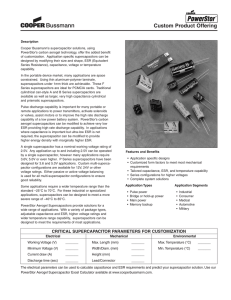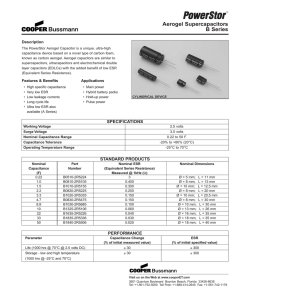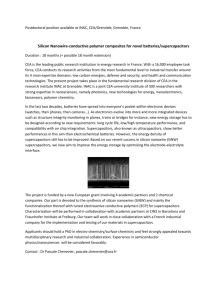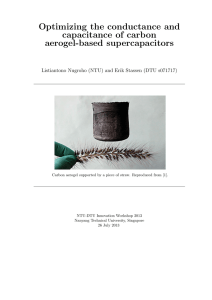Using aerogel supercapacitors as energy storage in DSL modems
advertisement
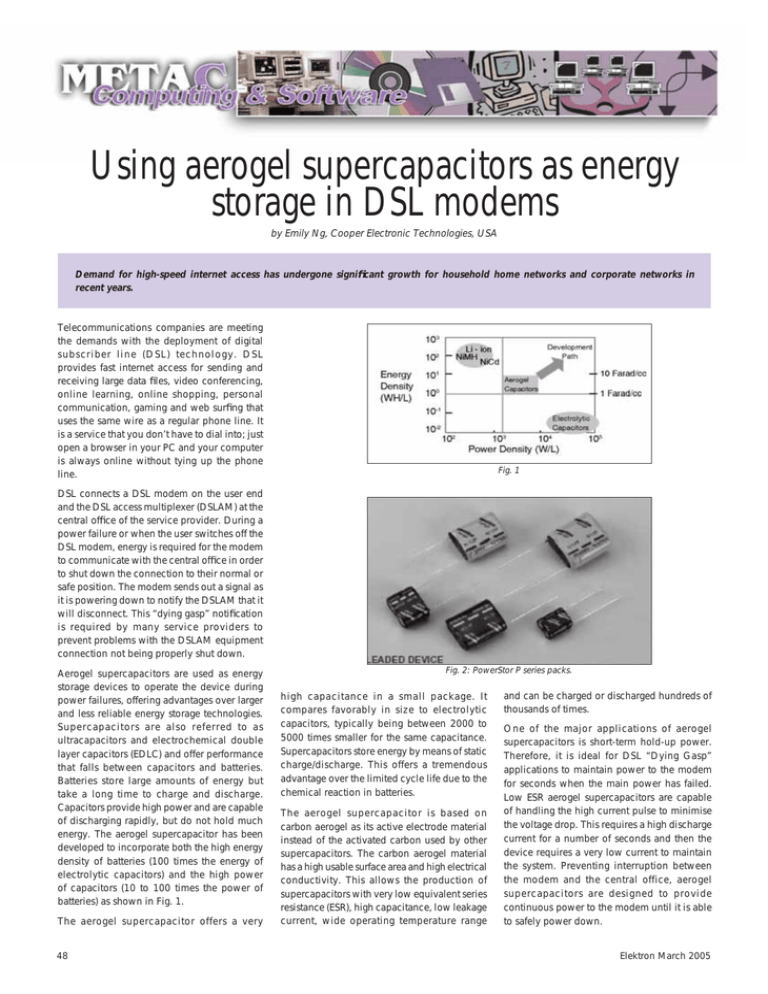
Using aerogel supercapacitors as energy storage in DSL modems by Emily Ng, Cooper Electronic Technologies, USA Demand for high-speed internet access has undergone significant growth for household home networks and corporate networks in recent years. Telecommunications companies are meeting the demands with the deployment of digital subscriber line (DSL) technology. DSL provides fast internet access for sending and receiving large data files, video conferencing, online learning, online shopping, personal communication, gaming and web surfing that uses the same wire as a regular phone line. It is a service that you don’t have to dial into; just open a browser in your PC and your computer is always online without tying up the phone line. Fig. 1 DSL connects a DSL modem on the user end and the DSL access multiplexer (DSLAM) at the central office of the service provider. During a power failure or when the user switches off the DSL modem, energy is required for the modem to communicate with the central office in order to shut down the connection to their normal or safe position. The modem sends out a signal as it is powering down to notify the DSLAM that it will disconnect. This “dying gasp” notification is required by many service providers to prevent problems with the DSLAM equipment connection not being properly shut down. Aerogel supercapacitors are used as energy storage devices to operate the device during power failures, offering advantages over larger and less reliable energy storage technologies. Supercapacitors are also referred to as ultracapacitors and electrochemical double layer capacitors (EDLC) and offer performance that falls between capacitors and batteries. Batteries store large amounts of energy but take a long time to charge and discharge. Capacitors provide high power and are capable of discharging rapidly, but do not hold much energy. The aerogel supercapacitor has been developed to incorporate both the high energy density of batteries (100 times the energy of electrolytic capacitors) and the high power of capacitors (10 to 100 times the power of batteries) as shown in Fig. 1. The aerogel supercapacitor offers a very 48 Fig. 2: PowerStor P series packs. high capacitance in a small package. It compares favorably in size to electrolytic capacitors, typically being between 2000 to 5000 times smaller for the same capacitance. Supercapacitors store energy by means of static charge/discharge. This offers a tremendous advantage over the limited cycle life due to the chemical reaction in batteries. The aerogel supercapacitor is based on carbon aerogel as its active electrode material instead of the activated carbon used by other supercapacitors. The carbon aerogel material has a high usable surface area and high electrical conductivity. This allows the production of supercapacitors with very low equivalent series resistance (ESR), high capacitance, low leakage current, wide operating temperature range and can be charged or discharged hundreds of thousands of times. One of the major applications of aerogel supercapacitors is short-term hold-up power. Therefore, it is ideal for DSL “Dying Gasp” applications to maintain power to the modem for seconds when the main power has failed. Low ESR aerogel supercapacitors are capable of handling the high current pulse to minimise the voltage drop. This requires a high discharge current for a number of seconds and then the device requires a very low current to maintain the system. Preventing interruption between the modem and the central office, aerogel supercapacitors are designed to provide continuous power to the modem until it is able to safely power down. Elektron March 2005 To determine your aerogel supercapacitor requirements, four key parameters are required: • Working voltage, Vwv, in Volts • Minimum voltage, Vmin, in Volts • Average discharge current, Iload, in Amps • Discharge time, t, in seconds Using this information, the value of the aerogel supercapacitor required can be estimated. This calculation equates the energy needed during the hold-up period to the energy decreases in the supercapacitor, starting at Vwv and ending at Vmin and C is the capacitance in Farads (F). Energy needed during hold-up period: 1/2Iload (Vwv + Vmin) t (Joules) Energy decrease in supercapacitor: 1/2C(Vwv² - Vmin²) (Joules) Therefore, the minimum capacitance value that guarantees hold-up to Vmin (neglecting voltage drop due to IR) is: C= Elektron March 2005 The design of one single aerogel supercapacitor includes a radial-leaded cylindrical with nominal working voltage rating of 2,5 V. Cooper Bussmann offers the PowerStor brand of supercapacitors. This includes their P-series supercapacitors with leaded rectangular devices designed for 3,6 V and 5 V applications. For 5 V working voltages in DSL modems, P-series aerogel supercapacitors can be used. After adding a safety margin over the voltage, lifetime of the product, operating temperature and other considerations, the user can then choose standard capacitance values from 0,1 F to 1 F and 0,2 Ω to 20 Ω ESR measured at 1 kHz. Please note that DC discharge ESR will be 1,5 times higher than 1Khz figure. Fig. 2 shows the aerogel supercapacitors. The low impedance and high energy storage aerogel supercapacitors eliminate the need of using many relatively large electrolytic capacitors, while meeting the hold up power demand for DSL “dying gasp” applications. Contact Craig Jonsson, Advanced Product Technology, Tel (011) 792-6010, craig@aptsa.co.za 49
